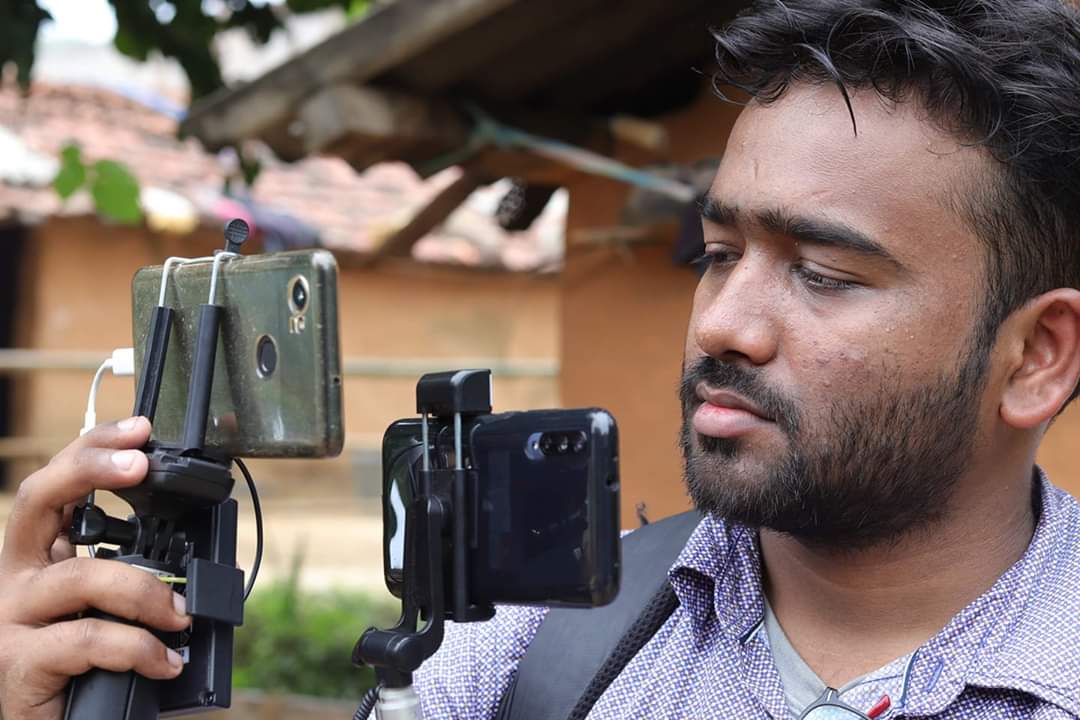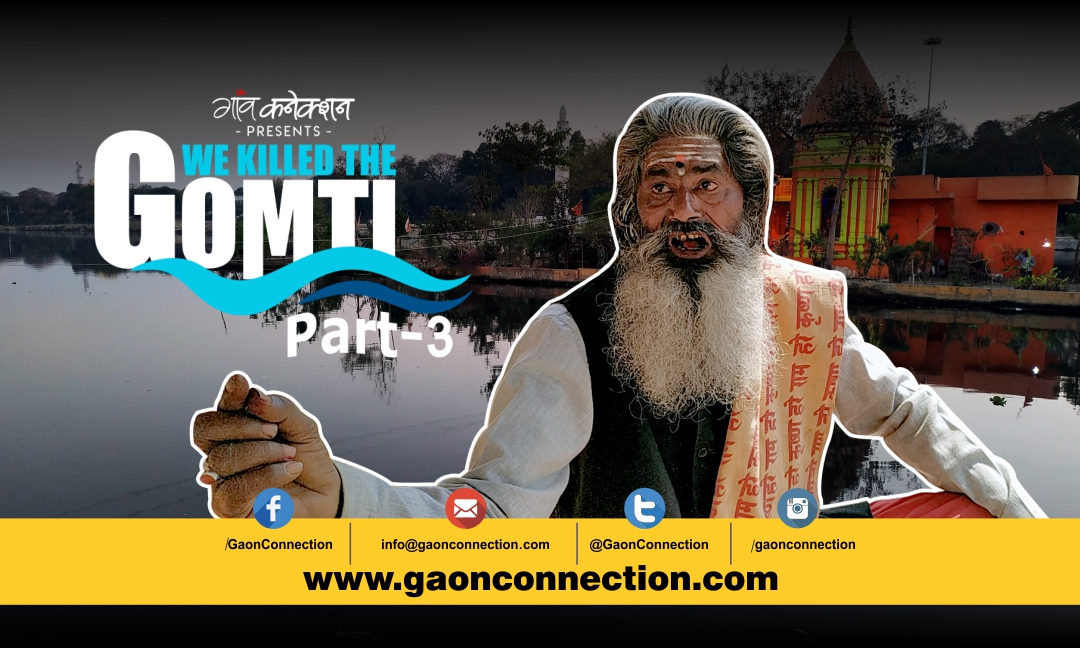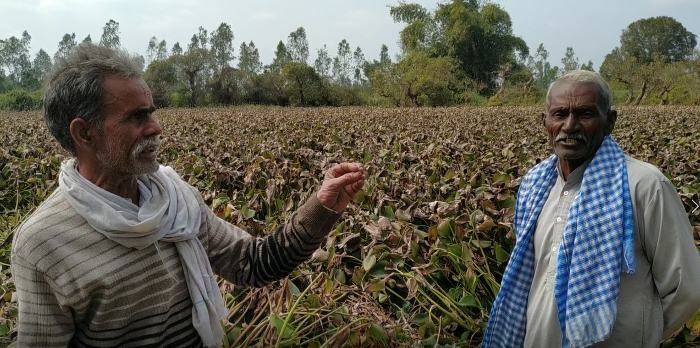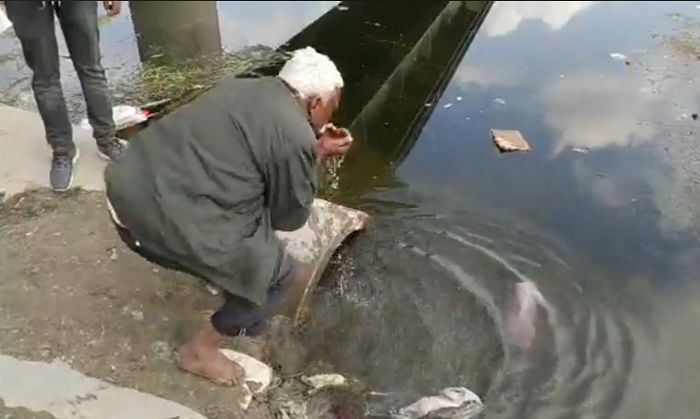“The Gomti river is like my mother … she is a friend to me. I could never abandon her.”
There are thousands who worship the river, yet it's full of filth and is dying a slow death. We spoke to many people, who got nostalgic talking about the Gomti – a river that once was


The Gomti river, which flows through eight districts in Uttar Pradesh, is dying a slow but certain death. We are killing it at its every twist and turn for our petty gains. In order to find out the extent of damage done, Gaon Connection’s team reached its origin at Madhav Tanda in Pilibhit, Uttar Pradesh, and undertook a four-day, 425-km-long bike expedition along its route to understand various issues plaguing the river.
Ranvijay Singh & Daya Sagar
Mukhtaar, a barbar, and Abbas, a zardozi artist, are childhood friends. They live in a mohalla in old Lucknow, close to the Gomti river. Fishing is a hobby and both of them have been fishing in the Gomti since they were kids. “Now there are no fish here. We have to go 20-30 kms far to catch fish. At times, we have to go to Ghaghra river in Sitapur and Gonda,” said Mukhtaar.
The Gomti, which flows through eight districts in Uttar Pradesh, is dying a slow but certain death. We undertook a 425-km, 4-day long bike expedition along its route to understand various plaguing the river.
While we were on our bike expedition along the Gomti, we met many people who were distraught to see the river dying. Most of them shared their childhood memories with us, memories that are associated with the Gomti – a river that once was.
The river originates from Gomat Taal in Pilibhit, Uttar Pradesh. There is an interesting mythological tale about the origin of the river. “There used to be a dense forest where the Gomat Taal now is. A saint named Durga Naath used to live here. Legend has it that he would go all the way to Gomukh, near Gangotri, to take bath every single day. However, as he grew old, he could not walk such a long distance. One day Gomti, the goddess, told the saint that the river would come to him as he was too old to walk. The saint gave her his slippers and stick and requested her to leave those things at the place from where the river would originate. The next day he found his belongings floating in the river. That’s how the river reached Gomat Taal. The river is also known as saint Vashishth’s daughter and Adiganga,” informed Dhaniraam Kashyap, 50, ex village head of Madhavpur Tanda.

People living along the bank of the river worship the Gomti. They all call it ‘Gomti mata’. We saw many people celebrating occasions like weddings and threading ceremonies along the banks of the river. For many, the river served as the final resting place of their loved ones.
We met Kundan Singh Kushwaha at Amiri ghat Lakhimpur. The 65-year-old devotee lives in Puvaya. The Amiri ghat is 30 kms from his place, but he visits it every new moon night to take holy dip in the Gomti. He informed us that the Pandavas spent few years of their exile there. According to him, the river is the second most holy river after the Ganga. “All your wishes would come true if you take a dip in the river,” he said.
He added: “The river used to be very wide when we were kids. Now that it’s very dirty, very few people take a dip in it. But since all my wishes have come true, I make it a point to come here every Amavasya.”
We also met Vipin Valmiki at this ghat. He informed us that the river had stagnated two-three years back, but now some government officials have shown interest in reviving the Gomti. “This is why the river looks clean now. It’s important that the authorities come up with a concrete plan otherwise it will stagnate again. The government is spending so much on cleaning the Ganga. There is a fancy Riverfront in Lucknow. But the authorities have never bothered to find out the condition of the river between its point of origin and the fancy riverfront,” he said. Just when he was talking about the government’s apathy, an election rally crossed us. People were sloganeering ‘phir ek baar, Modi sarkaar’.

At Ekottar Nath, Pilibhit, we met Suranath Mishra, 72, and his friend Rameshwar. They took us along with them to a spot where the river was completely stagnant. The area was covered with weeds and there was not a drop of water in the river. Reminiscing about his childhood, Suranath Mishra said: “My friend and I had more than 100 cows and buffaloes. We would bring them here. They would roam around, drink river water and bathe in it. We would prepare supper and eat it. Those were good days. The river looked like a river, unlike what it has reduced to now.”
Talking about the river, TH Khan, a chemistry professor and an environmentalist, gets nostalgic. “My 85-year-old uncle, Dr AH khan, was a hunter who would go hunting along with Pilibhit’s famous hunter Bharat Singh. They all would go for picnics at the river and spend quality time with their loved ones. Since people worship this river, open defecation has always been banned here.”
Amitabh Agnihotri, a senior journalist living in Pilibhit and a social worker, too went on a nostalgia mode while talking about the river. He has been a vocal critic about the river’s plight and has been a part of various committees that were set up to revive the river. “Unfortunately, I have always seen this river like this. It disappears as soon as it leaves its place of origin, Madhav Tanda. You get a glimpse of it at some places, but till it reaches Sitapur, you can hardly call it a river. The usual practice is that people take out canals out of main rivers, but in the case of this river, we had to build artificial canals so that we could keep it alive.”
A few years back, the river was linked with various canals to prevent it from going completely dry. This canal is called Sharda Nahar. The river dries up only when water from the canals stop reaching the river.
“Earlier, the river used to cross through dense forests. There were many animals in the jungle. But gradually we encroached upon both, the forests and the river,” said Kirath Prasad, 54, a resident of Hamriya Patti, Pilibhit.
When we set out on our bikes from Madhavpur Tanda, Pilibhit, from where the Gomti originates, and unil we reached Naimisharanya, Sitapur, the river was in a pathetic condition. Many temples and ghats have come up along the bank of the river in this stretch. The river is dirty at these ghats.

What we also discovered was that at Pilibhit, Shahjahanpur and Lakhimpur the river is not a full-fledged water body, but it resembles a cluster of ponds. “There has never been a dearth of water in this region. In fact, one had to dig just 5-10 feet and one could find water. There is an interesting tale. There was so much water that the river was a threat to people living around. The Gomati goddess hence decided that the river would not be a full-fledged water body in this region, but a cluster of small ponds,” informed Sunil Kumar, a shopkeeper residing in Triveni Ghat, Pilibhit.
We met some fishermen who said not just the river, marine animals are getting affected too. One could find a variety of fish, but now there is no marine life in this river. The fishermen are finding it difficult to survive. “Earlier I could earn around Rs 300 by selling fish, but now I barely get Rs 100 a day,” said Anil Prasad, a fisherman from Lucknow.
Ashwini Dwivedi, a resident of Lucknow, said: “The river used to be so clean that one could see shells lying at the bottom. As kids, we would play various games here. But by 2005, the water became polluted. We started getting skin infections and our eyes would burn after swimming in the river. Then we stopped coming here. In fact, thousands of fish were found dead in the river one day because of pollution.”
Ranjit Singh, a counselor at Daliganj in Lucknow, calls the river his childhood friend. “I have spent my childhood and college life by this river. We used to spend a lot of time sitting there. There are so many memories attached to this river. The river is like my mother….she is a friend to me. I could never abandon her.” He has even formed a group called ‘Paryavaran Sena’ to save the Gomti. Many officials, social workers and politicians are a part of this group. They all clean up the river every Sunday.
While many people were nostalgic while talking about the river, but there are many who have seen the river die a slow, but steady, death. Ashish, 35, who runs a tea stall at Shahjahanpur, said: “The river used to be wider than this road. We would go there a lot. But now there is no point going there.” He pointed at his younger brother Shivam and said: “He probably does not even know that a river used to exist.” Shivam nodded in affirmation.
(This story is Part 3 of the five-story series ‘We killed the Gomti’)
Read Part One here
Read Part Two here

